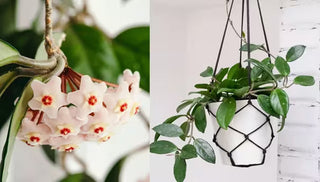Looking for a carefree trailing houseplant with plump leaves and gorgeously-scented flowers? Look no further than the world of Hoyas!
Belonging to the Apocynaceae family, Hoyas are evergreen perennials native to the tropics Asia, Australia, and the Pacific Islands. Commonly known as "wax plants" due to their waxy, stiff leaves, Hoyas are characterized by their fragrant, star-shaped flowers, and trailing growth habit, which makes them perfect for windowsills and shelves. One of the most impressive things about hoya plants is their long lifespan.
Types of Hoya to Try
Hoyas offer a huge variety of species and cultivars! Hoya carnosa is classic species standard, but if you’re after something more unique you'll be sure to find something in the 500+ species of hoya:
Hoya carnosa 'Krimson Queen': a gorgeous variegated variety whose leaves emerge pale pink before fading to cream and white
Hoya carnosa 'Chelsea': thicker leaves that are slightly puckered to form a cup shap
Hoya kerri: known as Sweetheart Hoya, this plant features adorable heart-shaped leaves
Hoya obovata: rounded leaves in dark green with minimal silvery speckling
Hoya curtisii: a rare mounding, trailing hoya featuring miniscule leaves
Hoya multiflora 'Shooting Star': dark green leaves with prolific white and yellow flowers that resemble tiny stars
Hoya linearis: one of the more challenging hoyas to grow, this plant features slender, slightly fuzzy leaves are paired with citrus-scented, white flowers
Best Growing Conditions for Hoya Plants
Light
Hoya Plants thrive in bright, indirect light. They can endure some direct morning sunlight but should be shielded from intense afternoon rays. A spot near an east or west-facing window is perfect.
Soil
Hoyas prefer well-draining, airy soil. A mix of potting soil, orchid bark, and perlite creates the ideal "chunky" texture is lightweight and full of organic matter. Good drainage is essential to prevent root rot.
Humidity
Hoyas are accustomed to high humidity environments, though their waxy, thick leaves do help them tolerate periods of dry air. They should be just fine in standard room humidity.
How To Care for a Hoya Plant
Watering
Water your Hoya when the top inch of soil feels dry. They prefer to dry out slightly between waterings. Overwatering can lead to root rot, so ensure your pot has good drainage.
Fertilizing
During the growing season (spring and summer), fertilize your Hoya with a balanced, water-soluble fertilizer every month. In winter, reduce feeding as the plant’s growth slows.
Pruning
Pruning isn’t usually necessary for Hoyas, but you can trim them to control their size or remove any dead or damaged foliage. Avoid cutting off the long tendrils, as these are where new flowers will form.
Repotting
Hoyas don’t mind being a bit root-bound and only need repotting every couple of years. Being slightly root-bound may encourage blooming. When you do choose to repot, pick a slightly larger pot and do it in the spring.
Propagation
Hoyas can be easily propagated through stem cuttings. Place a stem cutting with at least one leaf node in water or moist soil, and roots should develop in a few weeks.
Common Problems with Hoya Plants
Pests and Diseases
Watch out for pests like mealybugs, aphids, and spider mites. Treat any infestations with insecticidal soap or neem oil. Hoyas are generally disease-resistant but be cautious of overwatering to prevent root rot.
Toxicity
Hoyas are non-toxic to pets and humans, making them a fantastic addition to homes with pets and children.
Hoya Plant FAQs
Q: Why are my Hoya’s leaves wrinkling?
A: Wrinkly leaves can be a sign of an underwatered, too-dry plant. Hoyas prefer to have soil dry out between waterings, but then you'll want to follow that with a thorough, deep soak. Try putting the pot into a dish of water for 30 minutes to "bottom-water" the plant and ensure the roots are in contact with moisture. Be sure to drain the water afterwards so the plant is sitting in water continuously.
Q: How do I encourage my Hoya to bloom?
A: Encourage blooms by providing additional bright light and allowing your Hoya to become slightly root-bound. During the growing season (spring and summer), provide regular weakly fertilizer.
Q: Can Hoya Plants grow in low light?
A: While Hoyas can survive in low light, they thrive and bloom best in bright, indirect light. Low light conditions can lead to fewer flowers and leggy growth.
As a low-maintenance, non-toxic, and long-lived houseplant, hoyas are a natural addition to your indoor houseplant collection. With the huge number of Hoya species and varieties out there, there is bound to be one you haven't tried growing. Happy Hoya-ing!





